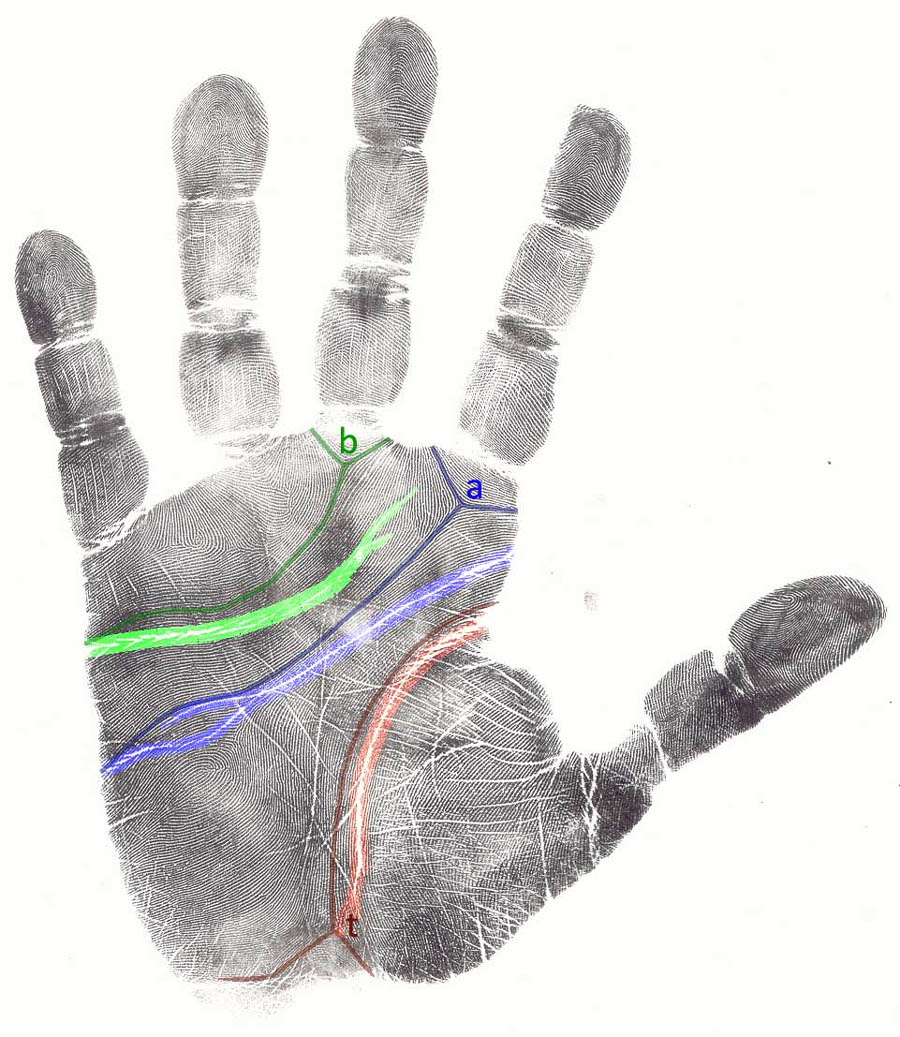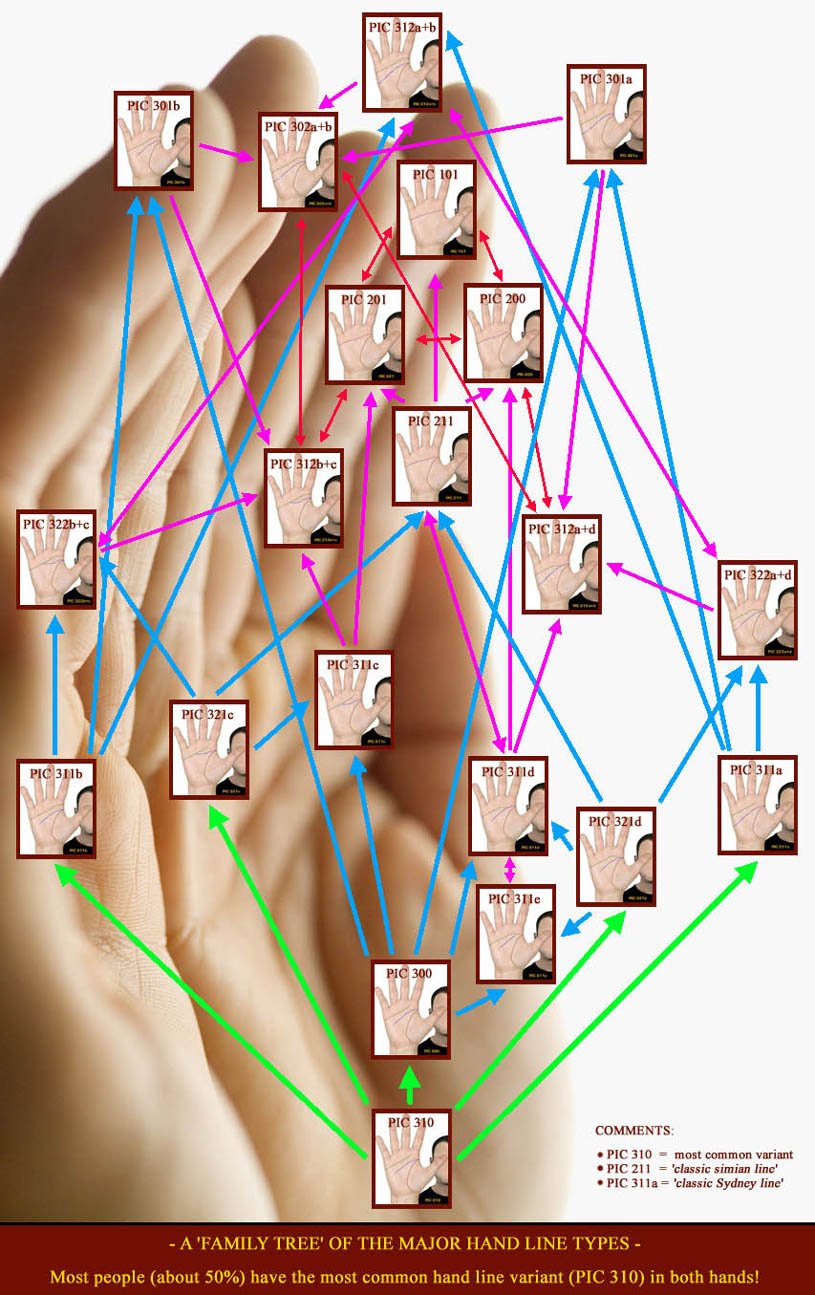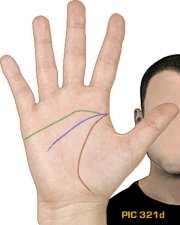
HAND LINES RESEARCH - The nature of the Palmar Creases!
- INTRODUCTION -
The 3 major palmar creases!
Learn how to recognize & understand the nature of the palmar creases
in the palm of your hands!

![]() PALMAR CREASES INDEX:
PALMAR CREASES INDEX:
INTRO: The nature of the 3 primary palmar lines
• EMBRYOLOGY: Palmar crease morphogenesis!
• PRIMATOLOGY: Palmar creases in primates?
• EVOLUTION: Palmar crease devolopment in time!
• SCIENCE: Early classifications of major hand lines
• PALMISTRY: An overview of the other hand lines
• ABERRANT TRANSVERSE CREASES - a family tree
• PIC MODEL: 21 variants of hand line formations
• ADVANCED PIC MODEL: 3 malformation types
• HAND SIGN TUTOR: 75 Hand line signs - overview
• HAND LINE STUDIES: Males vs. females, Down syndrome, autism... what do hand lines reveal?

What do we really know about the lines in the palm of our hands? This section presents an overview of detailed facts about the hand lines, seen from various perspectives - including e.g.: evolution, primatology, embryology, aberrant- and normal variations, and palmistry vs. academic science. The most interesting studies from the past are summarized, and an innovative 'family tree' model is presented focussed on just the palmar transverse creases.
The study of the palmar lines [folding creases] traces back to the ancient civilisations of the Chinese and Indians as early as 3,000 years B.C. Historically the palmar lines became many centuries ago the most important 'tool' of the classic palmist. This explains why in all regions of the world the palmar lines became synonymous with the stigma of fortune-telling (advocated by so-called 'predictive palmistry') - and subsequently debarring the hand lines from the scientific courts (R.S. Bali, 1994).

The path of the 3 major creases relates to: 1 - the path of the dermatoglyphics (starting in palmar triradii a, b and t); 2 - finger motorics. CLICK FOR LARGE VERSION!
However, the nature of the hand lines is still not very well understood. Palmists usually focuss on the 'practical' aspect of how to interpretate characteristics of all individual lines - any attempt to describe/discuss the fundamental 'pattern' & the combination of the lines is usually missing. Though there are exceptions in the field of palmistry. An example concerns the work of Japanese palmist Hachiro Asano, who presented a classification model for the combination of the 3 primary lines* (Asano's model includes 6 categories for the combination of the life line and the head line + 3 types related to the heart line).
* The three 'primary palmar lines' include: the life line (radial longitudinal transverse crease), heart line (distal transverse crease), and head line (proximal transverse crease); the path and position of the 3 major creases is related to both the path of the dermatoglyphic main lines (which start in the palmar triradii) & the finger motorics.
Meanwhile, academic scientists have managed to developed a usefull paradigma for describing the basic characteristics of the fingerprints & dermatoglyphics, a likewise approach for the basic characteristics of the major hand lines is still missing. R.S. Bali (1994, p.127) wrote:
"In spite of the fact that creases for the last one century are under scientific consideration for want of an appropriate system for crease classification, the search is still on."
The situation has not really changed since then. Despite the fact that various scientists did publish detailed proposals for the classification of primary palmar crease formations, none of these attempts have been adopted widely. And beyond the confirmed diagnostic significance of the 'simian crease' and the 'Sydney line', other specified markers for the 'primary palmar lines' with confirmed diagnostic signficance were never identified.

In 2017 a new innovation is presented focussed on the 'palmar transverse creases' only, featuring 20 basic variations (with multiple variants for the simian crease, Sydney crease & Suwon crease). The significance of these variations, and the featured horizontal - and vertical groups will be explored in the near future.

In 2015 an innovative model is introduced: the 'PIC model' has been designed for the identification of the characterstics in the 3 'primary palmar lines' COMBINED! The 'PIC model' describes 21 formation types for the three primary lines (12 basic types - but 5 of these basic types can manifest through multiple variants). The most common variations in the 3 'primary palmar lines' can be described with 3 simple mathematical rules; a variations in the distribution of the variants have been explored for various populations.

Typically, the hands of far most people are featured with 3 major hand lines: the so-called 'primary palmar creases' (primates usually have 4 or more major lines).
A typical characteristic of the 'primary palmar creases' is that they usually do not intersect - only an intersection between the so-called 'life line' [longitudinal crease] and the 'head line' [proximal transverse crease].
Another typical aspect of all 'primary palmar creases' is that in far most people none of these lines crosses the full palm - which is a big difference compared to the hands of primates (human apes & monkeys) which are usually featured with multiple lines that cross the full palm (horizontally).
This section presents a new attempt to describe and understand the fundamentals of the 3 'primary palmar lines'. The model was composed from the basic components of hand crease morphogenesis (embryology formation), primatology, and the evolution of the human hand in the history of human kind.
Basically, this attempt presents an innovation, named: the 'PIC model' describing 21 typical variants of 'primary palmar line' formations (12 basic types) - each variant describes a specific combination of basic characteristics in the 3 primary palmar lines of the hand.
Each PIC code type can be described with a 3-digit 'PIC code', composed by the number of:
• P - Primary lines [varies from: 1 to 3];
• I - Intersections between primary lines [varies from: 0 to 2];
• C - Complete transversal primary lines [varies from: 0 to 2].
The details of how to use and apply this model are explained in the section: the PIC MODEL: 12 variants of hand line formations.

NOTICE: The 'primary palmar creases' have a few other typical characteristics - e.g. they usually follow a foccussed but slightly curved, oblique path. The PIC-model is also featured with an advanced supplement for classifying additional minor variations - including: a large interruption, large splitting, and lack of a natural curve (the details are presented in the section ADVANCED PIC-MODEL).
![]() PREVIEW: 4 examples from the 'PIC-model'!
PREVIEW: 4 examples from the 'PIC-model'!

• PIC type '310' (= the most common variant of the 21 formation types):
The most common PIC-variant of all primary palmar crease formations is featured with the PIC code '310' [NOTICE: 3 = three 'primary palmar lines', 1 = one 'intersection' between those 'primary palmar lines', and 0 = no 'complete transversal lines'].

• PIC type '300' (= the second most common variant):
The second most common PIC-variant of all primary palmar crease formations is featured with the PIC code '300' [NOTICE: 3 = three 'primary palmar lines', 0 = no 'intersection' between the 'primary palmar lines', and 0 = no 'complete transversal lines'].
NOTICE: An important aspect of the 'PIC model' is that it provides a fundamental understanding of how the simian crease and the Sydney line can be recognized as related palmar crease variants - and this also illustrates why both lines often appear to have a similar significance in the perspective of hand diagnostics (for example in Down's syndrome & fragile X syndrome).

• PIC type '211' (= the typical 'simian crease'):
A less common PIC-variant concerns the (complete) 'simian crease', which is featured with the PIC code '211' [NOTICE: 2 = two 'primary palmar lines', 1 = one 'intersection' between the 'primary palmar lines', and 1 = one 'complete transversal line'].

• PIC type '311a' (= the typical 'Sydney line'):
Another PIC-variant concerns the so-called 'Sydney line', which is featured with the PIC code '311a' [NOTICE: 3 = three 'primary palmar lines', 1 = one 'intersection' between the 'primary palmar lines', and 1 = one 'complete transversal lines'].
A complete overview of all 21 PIC-variants is presented in the section: the PIC-MODEL: 21 types of (primary) hand line formations, where you can also find the 'family tree' - which describes the evolutionary connections between the individual variants (the picture at the bottom of this page concerns a preview of this 'family tree').
NOTICE: In the (near) future more specified info will be presented for how hand lines vary according the 21 PIC TYPES vary among e.g.: men and women; (ethnic) populations; people who have Down's syndrome, autism or dyslexia; and people who display typical personality characteristics (according the Big Five personality model).
But first a few more fundamental questions need to be answered. For example, how do the individual hand line characteristics develop?
In order to understand this more properly you can now take a look at the formation of the hand lines in the hand of an embryo! ...more.
For a better understanding of the unusual characteristics of the simian line, one can use the section 'hand lines (palmar creases)' - which includes the introduction of the innovative 'PIC-model' (which should serve as a helpful 'tool' to classify the COMBINATION of the core characteristics in the three major hand lines!).
The 'PIC model' demonstrates that basically there are up to twelve types of simian lines - most of them are quite rare, but three of the simian related 'PIC types' (see the pictures below) are relatively common: each of these PIC variants can be noticed in more than 1% of the population!!
Read more about the 'complete'- and 'incomplete' simian line variants in: 'How to recognize a simian line?'



The three most common simian line variants:
PIC type 211 (complete), PIC type 311d (incomplete), and PIC type 321d (incomplete).
[More details available in the section: 'What can hand lines reveal?']
Next major section:
• The notorious single palmar crease! (a.k.a. the 'simian line')